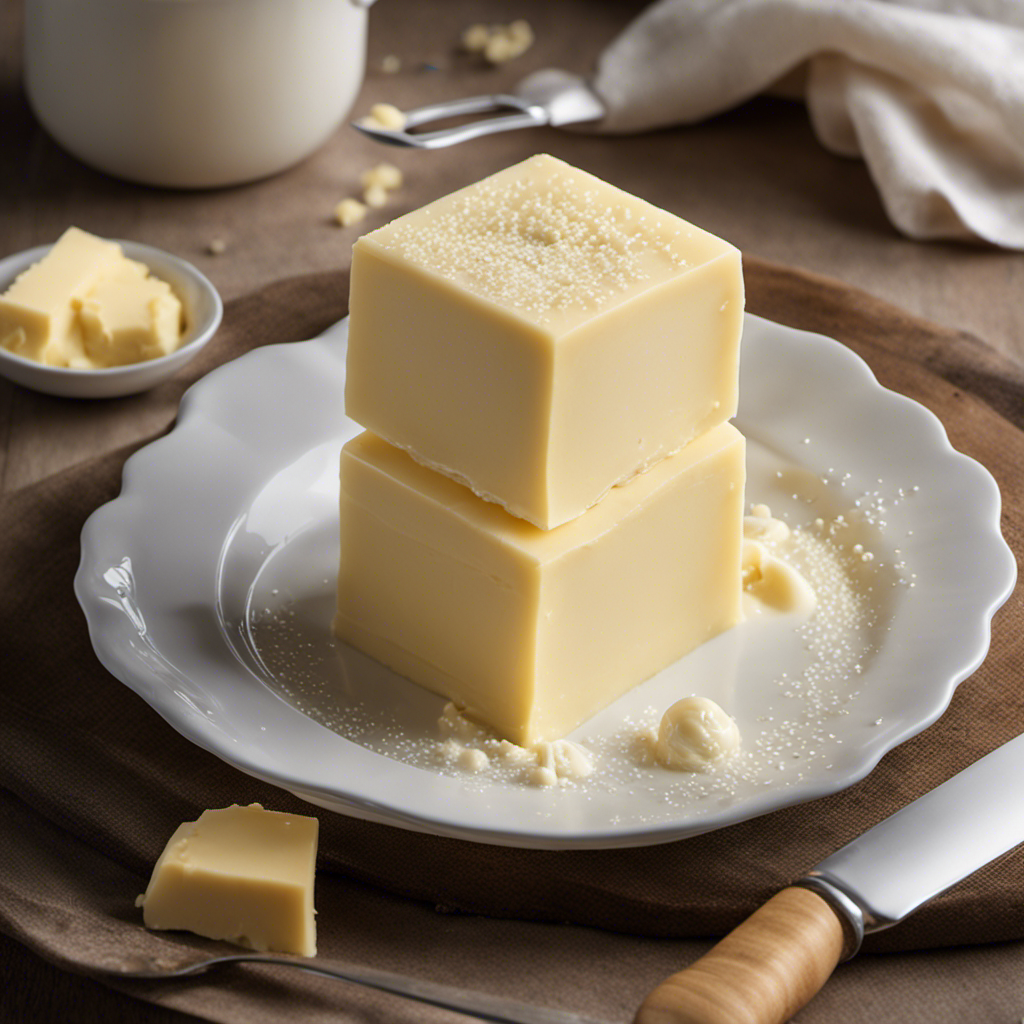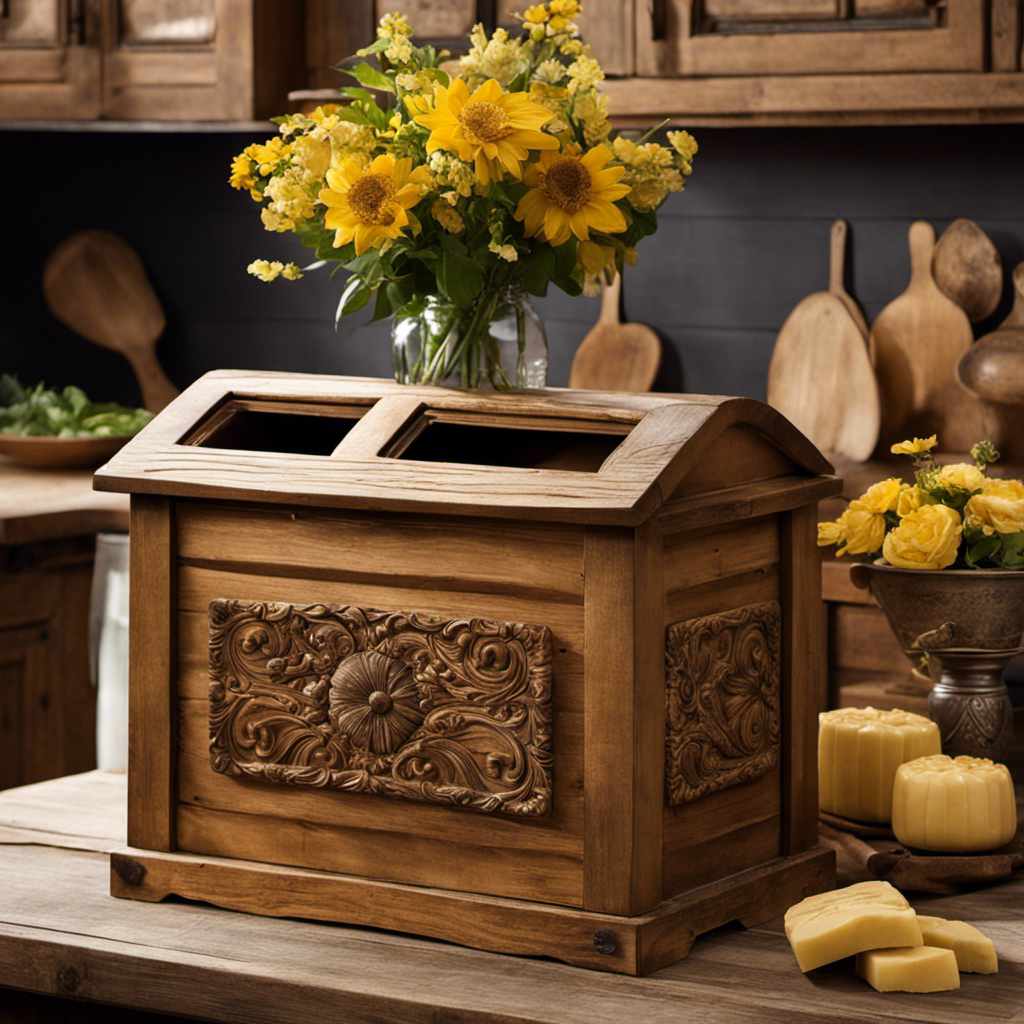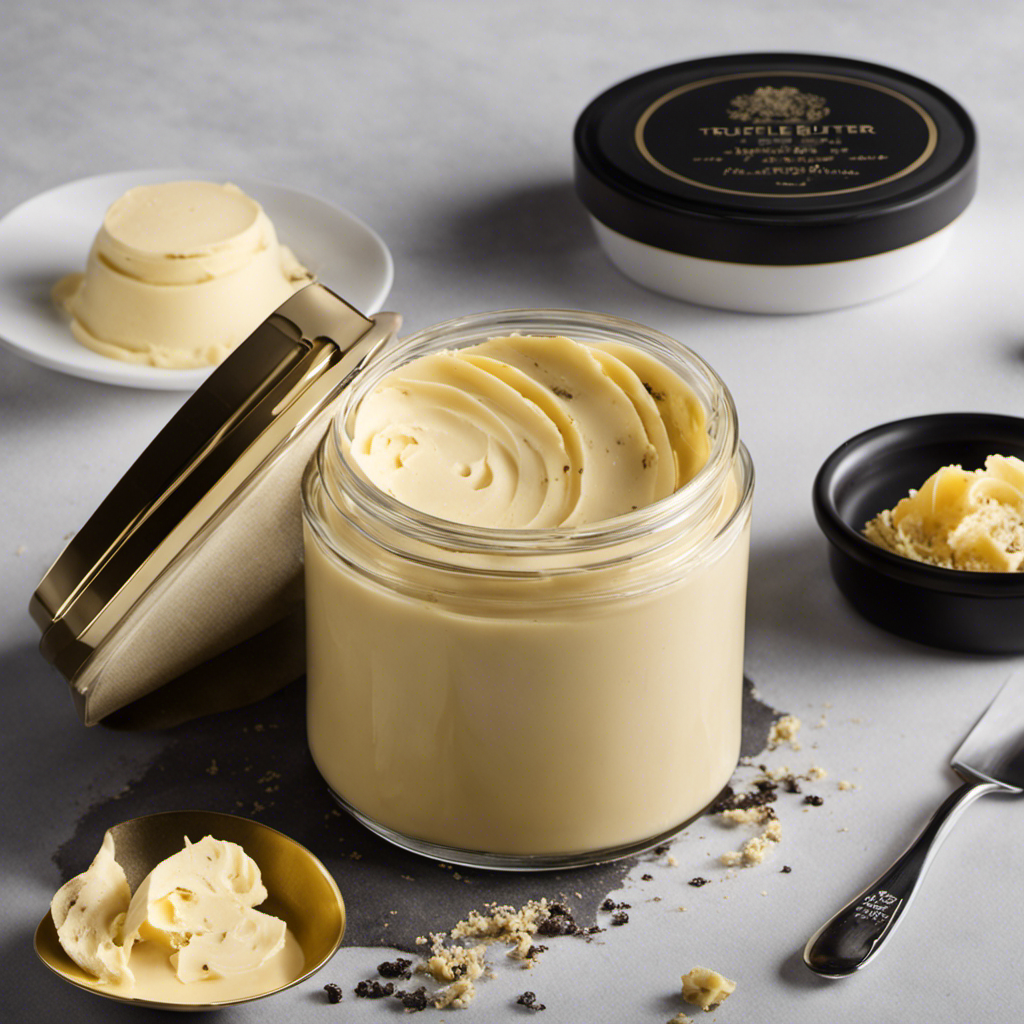I’ve always loved the taste of fresh, creamy butter spread on warm, toasted bread. However, I often found myself struggling with a hard lump of butter that would tear my bread. This led me to seek out tips on how to keep butter soft and easy to spread.
Through my research and experimentation, I’ve learned some effective techniques that I’m excited to share with you. In this article, I’ll guide you through the proper storage techniques, temperature control, and clever tools to ensure your butter stays soft and ready to use.
Key Takeaways
- Butter crocks, butter bells, and small airtight containers are effective storage options for keeping butter soft and spreadable.
- Temperature control is crucial for maintaining the spreadable consistency of butter, including leaving it at room temperature, grating cold butter, storing it in the refrigerator with an airtight container, or using a butter dish with a lid.
- Butter keepers, such as butter crocks, provide an airtight environment to keep butter soft without refrigeration, and they also help maintain the butter’s freshness for longer periods of time.
- Adding salt to butter can act as a preservative, doubling or tripling its shelf life, making it a simple and effective method to prolong its freshness.
Proper Storage Techniques
Proper storage techniques can help keep butter soft and spreadable. One popular option is using a butter crock, which is a traditional and effective way to store butter at room temperature. A butter crock consists of two parts: a base filled with water and a lid that holds the butter. The water creates a seal that keeps air out and helps maintain the butter’s freshness and softness.
However, if you don’t have a butter crock, there are alternative methods to keep your butter soft. One option is using a butter bell, which works similarly to a butter crock but has a different design. Another alternative is using a small airtight container and keeping the butter at room temperature.
Regardless of the method you choose, proper storage is essential for enjoying soft and spreadable butter.
Temperature Control
To maintain a spreadable consistency, it’s crucial to control the temperature of butter. There are various butter softening methods and storage hacks that can help in achieving the perfect texture for your butter.
One popular method is to leave the butter at room temperature for about 30 minutes before using it. This allows it to soften without melting completely.
Another method is to use a grater to shred cold butter, which helps it soften faster.
When it comes to storage, keeping butter in an airtight container in the refrigerator can help maintain its freshness and prevent it from absorbing any unwanted odors.
Additionally, placing butter in a butter dish with a lid can keep it at a consistent temperature and prevent it from drying out.
Using Butter Keepers
When using butter keepers, it’s important to seal the container tightly to maintain freshness and prevent any unwanted odors from affecting the butter.
Butter keepers, also known as butter crocks, are designed to keep butter soft and spreadable without the need for refrigeration. These unique containers have a water seal that creates an airtight environment, keeping the butter fresh for longer periods of time.
To use a butter keeper, simply place a stick of butter in the lid, and fill the base with cold water. The water creates a barrier that prevents air and odors from reaching the butter.
Adding Salt to Extend Shelf Life
If you want to extend the shelf life of your butter, adding salt is a simple and effective method. Salt acts as a preservative by inhibiting the growth of bacteria and mold, which are the main culprits behind butter spoilage. By incorporating salt into your butter, you can significantly prolong its freshness and prevent it from going rancid.
To demonstrate the effectiveness of adding salt, here is a comparison table showcasing the shelf life of butter with and without salt:
| Butter with Salt | Butter without Salt |
|---|---|
| 2-3 months | 1-2 weeks |
As you can see, adding salt can double or even triple the shelf life of your butter. This simple technique is a great alternative storage method if you don’t have access to a butter keeper or prefer not to use one.
Now that we’ve explored how to extend the shelf life of butter, let’s move on to another important aspect of butter preservation: avoiding direct sunlight.
Avoiding Direct Sunlight
Direct sunlight can cause butter to spoil more quickly, so it’s best to store it in a cool, dark place. When it comes to butter storage alternatives, there are a few options to consider.
One option is using a butter dish with a lid. This helps to keep the butter protected from light exposure while also allowing easy access.
Another alternative is using a butter bell or keeper, which uses a water seal to create an airtight environment. This method helps to maintain the moisture content of the butter, preventing it from drying out. Moisture control is important because excessive moisture can lead to spoilage.
By storing butter in a cool, dark place and using these alternative methods, you can ensure that your butter stays fresh and ready to spread.
Speaking of freshness, preventing exposure to air is another crucial aspect of butter storage.
Preventing Exposure to Air
When it comes to preventing exposure to air and keeping butter fresh, there are a few key points to consider.
First, using air-tight butter storage containers can help to maintain the quality and flavor of the butter for longer periods of time.
Additionally, using a butter dish with a lid can also help to keep air out and preserve the butter’s freshness.
Air-Tight Butter Storage
To keep your butter soft, store it in an air-tight container. This is one of the most effective methods for preserving the freshness of butter. When exposed to air, butter can quickly become rancid and lose its smooth texture.
By storing it in an air-tight container, you create a barrier that prevents air from reaching the butter and causing it to spoil. This method also helps to maintain the moisture content of the butter, ensuring that it stays soft and spreadable.
It is important to choose a container that is specifically designed for butter storage, as it will provide the best protection against air and external odors. Remember to always keep your butter in the refrigerator, as the cool temperature further helps to preserve its freshness and prevent spoilage.
Butter Dish With Lid
Storing your butter in a dish with a lid helps maintain its freshness and spreadability. A butter dish with a lid is specifically designed to keep the butter protected from air and other contaminants, ensuring that it stays soft and ready to use. The design of the dish prevents the butter from being exposed to oxygen, which can cause it to harden and lose its creamy texture. Additionally, the lid helps to seal in the moisture, preventing the butter from drying out.
In comparison to alternative storage methods, such as keeping butter in its original packaging or using a plastic container, a butter dish with a lid offers several advantages. Firstly, it provides a designated space for your butter, making it easier to locate and access. Secondly, the design of the dish allows for better portion control, as you can easily measure out the amount of butter you need. Lastly, a butter dish with a lid adds a touch of elegance to your dining table, making it a stylish and functional addition to your kitchen.
| Pros | Cons |
|---|---|
| Maintains freshness | Takes up countertop space |
| Easy to use and access | Requires regular cleaning |
| Adds aesthetic appeal | Not suitable for large quantities of butter |
Wrap in Wax Paper
Wrapping your butter in wax paper helps maintain its freshness and spreadability. It creates a protective barrier against air and moisture. This is one of the simplest and most effective butter storage hacks that I’ve come across.
Not only does it prevent the butter from absorbing unwanted odors from the refrigerator, but it also helps to keep it from drying out. Wax paper is an excellent alternative wrapping material. It is non-stick and allows for easy unwrapping. Plus, it is readily available and inexpensive.
When I wrap my butter in wax paper, I can confidently store it in the refrigerator without worrying about it spoiling or losing its softness.
Now, let’s explore another clever way to keep butter soft: incorporating butter bells.
Incorporating Butter Bells
When using butter bells, you’ll find it easier to keep your butter soft and spreadable. Butter bells are a great addition to any kitchen, providing a convenient way to store and use butter without the need for refrigeration.
Here are three important tips for butter bell care and cleaning:
-
Regular Cleaning: After each use, wash the butter bell with warm water and mild dish soap. Make sure to remove any remaining butter residue to prevent it from turning rancid.
-
Air Drying: Allow the butter bell to air dry completely before refilling it with fresh butter. This will help prevent any moisture from accumulating and spoiling the butter.
-
Proper Storage: When not in use, store the butter bell in a cool and dry place. Avoid exposing it to direct sunlight or extreme temperatures, as this can affect the texture and taste of the butter.
Frequently Asked Questions
Can I Store Butter in the Freezer to Keep It Soft?
I wouldn’t store butter in the freezer to keep it soft. There are alternative storage methods that work better. Freezing butter can change its texture and affect its taste.
Is It Safe to Store Butter at Room Temperature?
Storing butter at room temperature is safe and keeps it soft and spreadable. There are alternative methods to store butter, such as using a butter dish or a butter bell. Here are some tips for keeping butter fresh.
Can I Use a Regular Dish Instead of a Butter Keeper?
Using a regular dish instead of a butter keeper? Absolutely! Just leave it out at room temperature for a quick softening. But if you want butter to stay soft longer, consider investing in a butter keeper.
How Much Salt Should I Add to Extend the Shelf Life of Butter?
Adding a small amount of salt can help extend the shelf life of butter by inhibiting the growth of bacteria. However, there are alternative methods, like using a butter keeper or storing it in an airtight container in the refrigerator.
Can I Use a Regular Butter Dish Instead of a Butter Bell?
I’ve found that using a regular butter dish is a great alternative to a butter bell. It keeps the butter soft and spreadable without the need for refrigeration. Plus, there are other ways to keep butter soft, like using a butter keeper or a butter crock.
Conclusion
In conclusion, keeping butter soft is a simple yet crucial task. By implementing proper storage techniques, such as using butter keepers and avoiding direct sunlight, we can ensure its longevity and quality.
Temperature control and adding salt can also extend its shelf life. Additionally, preventing exposure to air and incorporating butter bells can maintain its softness.
Remember, by following these steps, you can enjoy the smooth and creamy goodness of butter whenever you need it.










